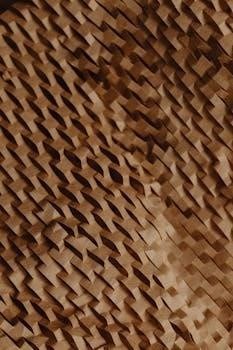Area of Composite Shapes⁚ A Comprehensive Guide
Area of Composite Shapes⁚ A Comprehensive Guide
This guide provides a comprehensive overview of composite shapes, focusing on understanding, calculating, and applying area formulas effectively. It covers breaking down complex figures into simpler geometric shapes and introduces the area addition postulate, essential for finding total areas.
Understanding Composite Shapes
Understanding composite shapes involves recognizing that these shapes are formed by combining two or more basic geometric figures like rectangles, triangles, circles, and other polygons. These shapes, also known as compound shapes, require a different approach than simple shapes when calculating their area. The key lies in identifying the individual basic shapes that make up the composite figure.
To effectively work with composite shapes, one must understand the characteristics of each constituent shape and how they interact within the larger figure. Recognizing overlapping and non-overlapping regions is crucial. Overlapping regions need to be accounted for carefully to avoid double-counting their area, while non-overlapping regions can be added together directly.

Visualizing how the simple shapes combine is essential for solving area problems involving composite figures. One can benefit from decomposing the shape, calculating individual areas, and combining those areas appropriately. Composite shapes are often encountered in real-world applications, making their study highly relevant and practical.
Breaking Down Composite Shapes into Simpler Figures

Breaking down composite shapes into simpler figures is a fundamental step in calculating their areas. This process involves identifying the basic geometric shapes that make up the composite figure, such as rectangles, triangles, circles, and semicircles. By dissecting the complex shape into these recognizable components, we can apply standard area formulas to each part.
Start by carefully examining the composite shape and sketching lines to separate it into its constituent figures. Label each of these simpler shapes for easy reference. It’s often helpful to redraw the individual shapes separately with their dimensions clearly marked. This visual aid simplifies the calculation process and reduces the likelihood of errors.
Pay close attention to how the shapes are connected. Some shapes might overlap, requiring subtraction of the overlapping area, while others fit together without overlap, allowing for simple addition of areas. This decomposition strategy transforms a complex problem into a series of manageable calculations, ultimately leading to the accurate determination of the composite shape’s area.
Calculating Areas of Basic Shapes (Rectangles, Triangles, Circles)
Calculating the areas of basic shapes is crucial for finding the area of composite figures. For rectangles, the area is found by multiplying the length by the width (Area = length × width). Triangles are calculated using half the base times the height (Area = 0.5 × base × height). Identifying the correct base and height is essential for accurate calculations.
Circles require using the formula Area = πr², where ‘r’ is the radius of the circle and π (pi) is approximately 3.14159. Make sure to square the radius before multiplying by pi. When dealing with semicircles or quadrants, calculate the full circle area and then divide by two or four, respectively.
Accurately applying these formulas is vital for solving composite area problems. Ensure you use the correct units of measurement and double-check your calculations to avoid errors. Mastering these basic area calculations is the cornerstone of understanding composite shapes and their areas. This skill allows for accurate and efficient problem-solving in various geometric contexts.
Area Addition Postulate⁚ Summing Individual Areas
The Area Addition Postulate is a fundamental principle in geometry that simplifies finding the area of composite shapes. This postulate states that if a figure is composed of two or more non-overlapping parts, the area of the entire figure is the sum of the areas of its individual parts.
To apply this postulate effectively, first, decompose the composite shape into basic shapes like rectangles, triangles, and circles. Calculate the area of each of these individual shapes using their respective formulas. Once you have the area of each part, simply add them together to find the total area of the composite shape.
For instance, if a shape is made of a rectangle and a triangle, calculate the area of the rectangle and the area of the triangle separately, then add these two areas to get the total area. Ensure that no parts overlap to adhere to the postulate’s condition. This method allows for easy computation of complex shapes by breaking them down into manageable components. The Area Addition Postulate is indispensable for solving composite area problems accurately.
Overlapping Shapes⁚ Identifying and Subtracting Common Areas
When dealing with composite shapes, overlapping regions can complicate area calculations. To accurately determine the total area, it’s essential to identify and subtract the common areas where shapes overlap. The basic principle involves finding the individual areas of the overlapping shapes, determining the area of the overlap, and then subtracting the overlap area from the sum of the individual areas.
Begin by breaking down the composite figure into its constituent shapes. Calculate the area of each individual shape as if they were separate. Next, carefully identify any regions where these shapes overlap. Calculate the area of each overlapping region. Finally, sum the areas of all individual shapes and subtract the area of each overlap to find the accurate area of the composite shape.
This process ensures that the overlapping area is not counted twice, providing a correct total area. Understanding how to subtract common areas is vital for solving complex composite area problems, especially in real-world applications where shapes often intersect.
Units of Measurement⁚ Square Centimeters, Meters, Feet, etc.
When calculating the area of composite shapes, it’s critical to understand and consistently use the correct units of measurement. Area is always expressed in square units, reflecting the two-dimensional nature of the calculation. Common units include square centimeters (cm²), square meters (m²), square feet (ft²), and square inches (in²).
The choice of unit depends on the scale of the problem. For smaller objects, square centimeters or square inches may be appropriate, while larger areas, such as rooms or buildings, are better measured in square meters or square feet. It is essential to convert all measurements to the same unit before performing any area calculations.
For instance, if a shape includes dimensions in both meters and centimeters, convert all measurements to either meters or centimeters before finding the area. The final answer must be expressed in the corresponding square unit. Always remember to include the unit in your final answer to provide a complete and meaningful result. Consistent and accurate unit usage is essential for accurate area calculations.
Real-World Applications of Composite Area Calculations
Composite area calculations are not merely academic exercises; they have extensive real-world applications across various fields. In construction and architecture, these calculations are vital for determining the amount of material needed for flooring, roofing, or wall coverings. Architects use composite area calculations to design buildings with irregular shapes, ensuring accurate material estimations.
In interior design, calculating the area of composite shapes helps in planning furniture layouts and determining the amount of fabric needed for upholstery or curtains. Landscaping also relies heavily on these calculations for estimating the amount of sod, mulch, or paving stones required for irregularly shaped gardens or patios.
Real estate professionals use composite area calculations to determine the value of properties with non-standard layouts. Understanding composite areas is also useful in manufacturing, where it helps in optimizing material usage and reducing waste when cutting out complex shapes from raw materials. From urban planning to everyday home improvement projects, the ability to calculate the area of composite shapes is a practical and valuable skill.
Using Worksheets for Practice and Skill Mastery
Worksheets are invaluable tools for practicing and mastering the calculation of areas of composite shapes. These worksheets provide a structured approach, allowing learners to break down complex problems into manageable steps. They often include a variety of composite figures, ranging from simple combinations of rectangles and triangles to more intricate shapes involving circles and other polygons.
By working through these exercises, students reinforce their understanding of basic area formulas and develop problem-solving skills necessary to identify and decompose composite shapes effectively. Worksheets also offer opportunities to practice applying the area addition postulate and handling overlapping areas, which are critical aspects of composite area calculations.
Moreover, worksheets typically include answer keys, enabling learners to self-assess their progress and identify areas where they may need additional support. Regular practice with worksheets enhances proficiency, builds confidence, and prepares individuals to tackle real-world applications of composite area calculations with greater accuracy and efficiency. Whether used in a classroom setting or for self-study, worksheets are essential resources for achieving skill mastery.

PDF Resources for Area of Composite Shapes

PDF resources offer a wealth of materials for learning and practicing area calculations of composite shapes. These resources often include comprehensive worksheets with varied difficulty levels, detailed diagrams, and step-by-step solutions. The printable nature of PDFs makes them ideal for both classroom instruction and independent study. Many PDFs also provide visual aids and interactive exercises to enhance understanding.
Furthermore, PDF resources may include real-world examples and applications, helping learners connect abstract concepts to practical scenarios. These resources frequently cover essential formulas, theorems, and problem-solving strategies necessary for accurately calculating areas. Additionally, some PDFs offer customizable templates, allowing educators to create tailored worksheets to suit specific learning needs.
The accessibility of PDF resources makes them a convenient and effective tool for students of all levels. Whether seeking introductory materials or advanced practice problems, PDF resources provide a structured and comprehensive approach to mastering the area of composite shapes. By leveraging these resources, learners can develop a solid foundation in geometric principles and improve their problem-solving abilities.
